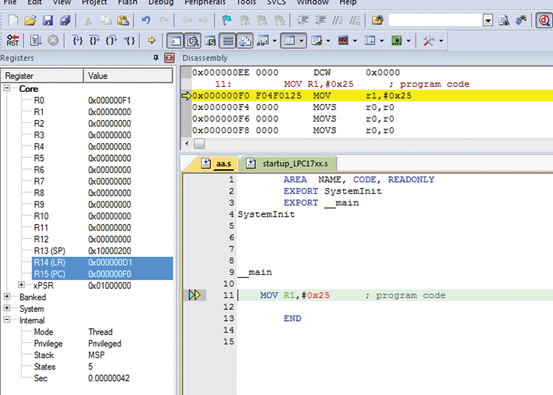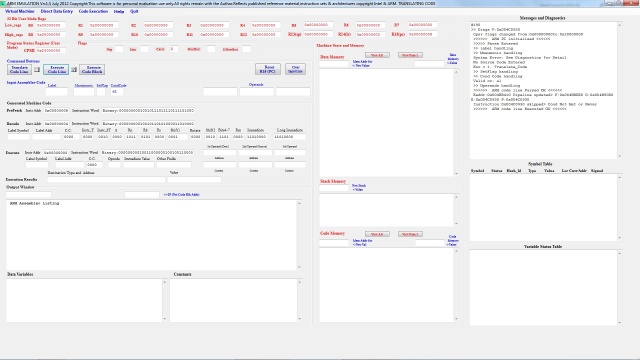
- Arm Asm To Hex Converter Software Download
- Asm To Hex Converter Software
- Arm Asm To Hex Converter Software Full
Lets convert a binary number such as 0101 1111 to hex. To do this we very simply look at the table and compare each nibble which is a combination of 4 bits. Keep in mind, 8 bits is equal to a byte. Nov 20, 2018 Your 0xFF000000 mask keeps the high byte (2 nibbles = 2 hex digits = 2 Fs). But then right-shifting by 28 keeps only the high one. The AND was useless.:/ I think you can optimize down to add r0, r6, r4 LSR #28, if you have '0' in r6. I don't think ARM can barrel-shift a register in an instruction with an immediate. It can simulate all the basic 8085 instructions, along with the Hardware and Software Interrupts. Inbuilt IDE and Assembler can be used to write and assemble 8085 ASM program and also load it directly to 8085 memory or even save it to HEX file. The program requires Microsoft.NET Framework 2.0 to execute and is compatible with all Windows. Jan 03, 2008 Sep 10, 2009. MPlab is definately free, you'll want to download it off the microchip site- you'll find the link on the right of some of their programming device product pages. Once you have the software, open your.asm and run quickbuild, followed by an export. This puts it into a.hex file you can program in with your favorite programming. Online HEX to ARM Converter. Offset (hex) 0x.
Hi guys…In this article let’s learn conversion.The ascii to Hex conversion logic is very simple.The hexadecimal numbers from 31H-39H are 0-9 numbers in ascii and
41H to 46H are A to F numbers. So we should first compare the number with 40H if it is lesser subtract with 30H and it is greater subtract with 37H.

| Asciivalue | Hexadecimal value |
|---|---|
| 31H | 01H |
| 32H | 02H |
| 33H | 03H |
| 34H | 04H |
| 35H | 05H |
| 36H | 06H |
| 37H | 07H |
| 38H | 08H |
| 39H | 09H |
| 41H | 0AH |
| 42H | 0BH |
| 43H | 0CH |
| 44H | 0DH |
| 45H | 0EH |
| 46H | 0FH |

Algorithm:
1)Initialize R0 with number which is required to find equivalent Hexadecimal number code.
2)Compare it with 40H and jump to label1 if it is equal.
3)Compare the carry bit to find which is greater and lesser.
4)If the carry bit is not set(it implies it is greater)jump to label2.
5)If it is lesser subtract the number with 30H.
6)If it is greater subtract the number with 37H.
Code goes here:
For a complete table of contents of all the lessons please click below as it will give you a brief of each lesson in addition to the topics it will cover. https://github.com/mytechnotalent/Reverse-Engineering-Tutorial
Arm Asm To Hex Converter Software Download
At the core of the microprocessor are a series of binary numbers which are either +5V (on or 1) or 0V (off or 0). Each 0 or 1 represents a bit of information within the microprocessor. A combination of 8 bits results in a single byte.
Before we dive into binary, lets examine the familiar decimal. If we take the number 2017, we would understand this to be two thousand and seventeen.
Let’s take a look at the binary system and the basics of how it operates.
If we were to convert a binary number into decimal, we would very simply do the following. Lets take a binary number of 0101 1101 and as you can see it is 93 decimal.
Adding the values in the value column gives us 0 + 64 + 0 + 16 + 8 + 4 + 0 + 1 = 93 decimal.
If we were to convert a decimal number into binary, we would check to see if a subtraction is possible relative to the highest order bit and if so, a 1 would be placed into the binary column to which the remainder would be carried into the next row. Let’s consider the example of the decimal value of 120 which is 0111 1000 binary.

1)Can 128 fit inside of 120: No, therefore 0.
2)Can 64 fit inside of 120: Yes, therefore 1, then 120 – 64 = 56.
3)Can 32 fit inside of 56: Yes, therefore 1, then 56 – 32 = 24.
4)Can 16 fit inside of 24: Yes, therefore 1, then 24 – 16 = 8.
5)Can 8 fit inside of 8: Yes, therefore 1, then 8 – 8 = 0.
6)Can 4 fit inside of 0: No, therefore 0.
7)Can 2 fit inside of 0: No, therefore 0.
8)Can 1 fit inside of 0: No, therefore 0.
When we want to convert binary to hex we simply work with the following table.

Lets convert a binary number such as 0101 1111 to hex. To do this we very simply look at the table and compare each nibble which is a combination of 4 bits. Keep in mind, 8 bits is equal to a byte and 2 nibbles are equal to a byte.
Therefore 0101 1111 binary = 0x5f hex. The 0x notation denotes hex.
To go from hex to binary it’s very simple as you have to simply do the opposite such as:
It is important to understand that each hex digit is a nibble in length therefore two hex digits are a byte in length.
To convert from hex to decimal we do the following:
Therefore we can see that 80 + 15 = 95 which is 0x5f hex.
Finally to convert from decimal to hex. Lets take the number 850 decimal which is 352 hex.
We put the numbers together from bottom to the top and we get 352 hex.
“Why the hell would I waste my time learning all this crap when the computer does all this for me!”
If you happen to know any reverse engineers please if you would take a moment and ask them the above question.
The reality is, if you do NOT have a very firm understanding of how all of the above works, you will NEVER get a grasp on how the ARM processor registers hold and manipulate data. You will NEVER get a grasp on how the ARM processor deals with a binary overflow and it’s effect on how carry operations work nor will you understand how compare operations work or even the most basic operations of the most simple assembly code.
I am not suggesting you memorize the above, nor am I suggesting that you do a thousand examples of each. All I ask is that you take the time to really understand that literally everything and I mean everything goes down to binary bits in the processor.
Asm To Hex Converter Software
Whether you are creating, debugging or hacking an Assembly, Python, Java, C, C++, R, JavaScript, or any other new language application that hits the street, ultimately everything MUST go down to binary 0 and 1 to which represent a +5V or 0V.
Arm Asm To Hex Converter Software Full
We as humans operate on the base 10 decimal system. The processor works on a base 16 (hex) system. The registers we are dealing with in conjunction with Linux are addressed in 32-bit sizes. When we begin discussion of the processor registers, we will learn that each are 32-bits wide (technically the BCM2837 are 64-bit wide however our version of Linux that we are working with is 32-bit therefore we only address 32-bits of each register).
Next week we will dive into binary addition! Stay tuned!